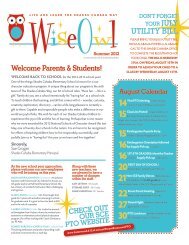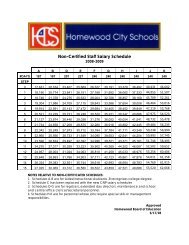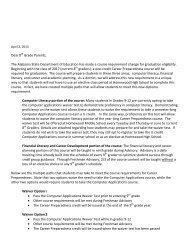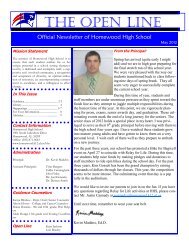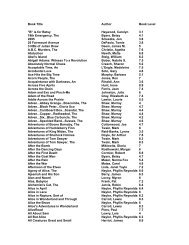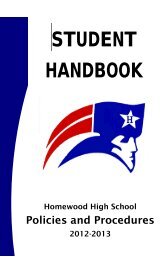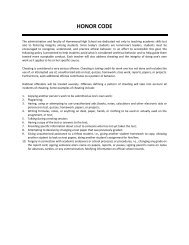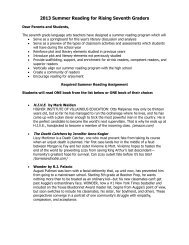Pre-AP English 10 - Homewood City Schools
Pre-AP English 10 - Homewood City Schools
Pre-AP English 10 - Homewood City Schools
Create successful ePaper yourself
Turn your PDF publications into a flip-book with our unique Google optimized e-Paper software.
2013 <strong>Pre</strong>-<strong>AP</strong> <strong>English</strong> Summer Reading AssignmentsIf you wish to earn 6 points extra credit, the typed hard copy of your assignment for TheGrapes of Wrath OR Huck Finn is due no later thanFriday, June 14th by <strong>10</strong>:00 a.m.If you miss the <strong>10</strong>:00 cut-off time, the work will be graded, but no extra credit will be merited.There will be a sign-in sheet.I. The Grapes of WrathRead The Grapes of Wrath by John Steinbeck. Complete the assignment listed below. Sinceall documents must be submitted to Turnitin.com, the information you provide for the novels willno longer be on cards. Simply type the information in MLA format (as you would an essay)separating each required element with the corresponding Roman numerals and letters. On thefirst day of school, you must turn in the hard copy of your assignment (unless you turned itin early for extra credit) and you must bring your assignments on a flash drive because youwill submit your two assignments toTurnitin.com on either the 1 st or 2 nd day of class inAugust.Please note that if your information resembles the content from Cliffs Notes, Spark Notes,Monarch Notes, Novel Guide, Shmoop, Gradesaver or any other “study aid,” (including anotherstudent’s work) you will receive a zero. If you have researched material, please paraphraseand cite the source using MLA guidelines.Required ElementsA. Setting and Mood1. Using the notes on archetypal settings, choose one of the settings thatis important in The Grapes of Wrath. Show how this particular setting contributesto the mood of the story and how it contributes to a theme. Be sure to stateyour theme as a complete sentence.2. Using the notes, show how the specific geographic location of the story
and the social context of that time period are important to understanding TheGrapes of Wrath.B. PlotUsing the notes on archetypal concepts, choose one of the quests orjourneys and show how that quest contributes to the plot and to one of thethemes of the story. Do not use the same theme you discussed in PartA.C. Characterization (Please separate each character)Using the notes on archetypal characters (those under “Archetypes” and/or those under“Other Archetypal Characters), choose one static character and the archetype that fitshim/her and one dynamic character and the archetype that fits him/her.1. Explain how each character exhibits the traits listed under that specificarchetype.2. Use specific examples from the novel to validate the traits for that specificarchetypal character.3. Show why the one is static and why the other is dynamic.D. ContrastChapter Seven gives a good example of characterization. Explain howSteinbeck contrasts the migrants’ naiveté with the salesman’s unscrupulousness.E. Style1. Explain the effectiveness and purpose of Steinbeck’s use of intercalary chapters(those that do not deal with the story of the Joads specifically).2. According to critic Peter Lisca (Lisca, Peter. The Wide World of John Steinbeck.New Brunswick, NJ: Rutger’s University <strong>Pre</strong>ss, 1958.), Chapter Seven is writtenin “harsh, staccato prose.” Why do you think Steinbeck may have written thischapter on selling used cars in this hectic prose?F. Symbolism1. What are the similarities of the turtle and Jim Casy?2. Choose one other symbol from the list below and explain its purpose infurthering the story:o Dusto Grapeso Willow treeo RainoG. Purpose and ToneUsing the notes provided for you concerning purpose and tone, do the following:1. Select a paragraph from the novel that lends itself to providing purpose andtone.2. Type the paragraph onto your paper being careful to put the paragraph inquotation marks and cite the page number.3. Highlight those words or phrases that you think are important in the paragraph.
4. Write those words or phrases and put out beside each what those words orphrases seem to mean (follow the pattern under Passage I and Passage 2 of“Recognizing Purpose and Tone in Writing.”)5. Write what possible conclusion can be reached from reviewing the underlinedwords, making sure to mention both the tone and purpose.You may use one of the tonal words on your handout or select another.If you wish to earn 6 points extra credit, the assignment for Huck OR The Grapes of Wrath isdue no later thanFriday, July 12th by <strong>10</strong>:00 a.m.If you miss the <strong>10</strong>:00 cut-off time, the work will be graded, but no extra credit will be merited.There will be a sign-in sheet.II.The Adventures of Huckleberry FinnRead The Adventures of Huckleberry Finn by Mark Twain. Complete the assignment listedbelow. Since all documents must be submitted to Turnitin.com, the information you provide forthe novels will no longer be on cards. Simply type the information in MLA format (as youwould an essay) separating each required element with the corresponding Roman numeralsand letters. On the first day of school, you must turn in the hard copy of your assignment(unless you turned it in early for extra credit) and you must bring your assignments on aflash drive because you will submit your two assignments toTurnitin.com on either the 1 stor 2 nd day of class in August.Please note that if your information resembles the content from Cliffs Notes, Spark Notes,Monarch Notes, Novel Guide, Shmoop, Gradesaver or any other “study aid,” (including anotherstudent’s work) you will receive a zero. Ifyou have researched material, please paraphraseand cite the source using MLA guidelines.
Required ElementsB. Setting and Mood1. Using the notes on archetypal settings, choose one of the settings thatis important in Huck Finn. Show how this particular setting contributes to themood of the story and how it contributes to a theme. Be sure to state yourtheme as a complete sentence.2. Using the notes, show how the specific geographic location of the storyand the social context of that time period are important to understandingHuckleberry Finn.C. PlotUsing the notes on archetypal concepts, choose one of the quests orjourneys and show how that quest contributes to the plot and to one of thethemes of the story. Do not use the same theme you discussed in PartA.D. CharacterizationUsing the notes on archetypal characters (those under “Archetypes” and/or those under“Other Archetypal Characters), choose one static character and the archetype that fitshim/her and one dynamic character and the archetype that fits him/her.1. Explain how each character exhibits the traits listed under that specificarchetype.2. Use specific examples from the novel to validate the traits for that specificarchetypal character.3. Show why the one is static and why the other is dynamic.E. IronyGive two examples of irony in the novel and briefly explain their effectiveness. Be sure tostate what type of irony (verbal, situational, or dramatic).F. Figurative language (similes, metaphors, personification, etc.)Find 3 examples of figurative language.Quote each example and give the page number.Identify the specific figure of speech and explain the purpose of each device as itrelates to the character, plot, tone, theme or mood of the story.G. Purpose and ToneUsing the notes provided for you concerning purpose and tone, do the following:1. Select a paragraph from the novel that lends itself to providing purpose and tone.2. Either photocopy and paste the paragraph onto the 5X8 card or write theparagraph on the card.3. Highlight those words or phrases that you think are important in the paragraph.
4. Write those words or phrases onto a 5X8 card and put out beside each whatthose words or phrases seem to mean (follow the pattern under Passage I andPassage 2 of “Recognizing Purpose and Tone in Writing.”)5. Write what possible conclusion can be reached from reviewing the underlinedwords, making sure to mention both the tone and purpose.You may use one of the tonal words on your handout or select another one.III. Read The Other Wes Moore: One Name, Two Faces by Wes MooreBe prepared for discussion and test on the novel.IV. Categories for ToneDefine each of the words listed on your handout. Because the words are so similar in eachrespective category, be careful with your definition. Don’t pick a definition because it’s short.Make sure that you can tell the subtle differences among all the words. You will betested on each individual category during the first few weeks of school.
Archetypal Settings(For theme)Archetypal settings have some universal aspect that is associated by most people with aparticular human experience. For example, underground places suggest a “belly of the whale”experience in which the hero confronts the darker or more unpleasant aspects of self, includingthe fear of death. Archetypal settings enrich the reader’s understanding of the author’s theme.Below is a partial list of such settings:‣ The river- life; refreshment; bringer of prosperity and victory; oblivion; cleansing‣ The garden-new life; innocence; temptation; return to nature; harmony; placewhere inner life is cultivated; paradise; place without responsibility‣ The wasteland- futility; despair‣ The maze- coming back to oneself; trials of a dark time; duality of entrapmentand release; duality of death and birth; a pilgrimage; circuitous route to agoal; tension; twists and turns‣ The castle-power; authority; nobility; awakening of the conscious mind; searchfor divine grace‣ The tower- deity; grandeur; nobility; refuge; security; truth; virginity; battlement;execution; death; slavery; warning‣ The wilderness- misery, persecution, unfruitfulness, wandering, cleansing,salvation, trial‣ The threshold- entry point which marks transition from one place to another;transition from one belief to another; boundary between two opposingregions‣ The desert- deprivation; death; terrifying aspects of life; barrier to the promisedland; infinite access; purification; prophetic vision‣ The ocean- chaos; the unfathomable; the beginning of life; the way one can getlost on a journey through lifeRemember that setting is the historical time, place, and social circumstances that create theworld in which characters act and make choices. The social circumstances will oftenilluminate and provide insights into the meaning of a literary work. Setting creates mood oratmosphere. Setting is also reflection of character. One should consider the way thecharacters respond to their environment and their adjustment to any changes in thissetting. The setting can be revealed through the author’s use of details about one or moreof the following:• Geographic location—landscape; scenery; room layout; buildings
• Cultural backdrop/social context/time period—occupations/working conditions; wayof life; way of talking and behaving; clothing; gender roles; traditions; habits;attitudes; customs and beliefs; speech patterns; laws• Artificial environment—rooms; cities; towns;• Props—tools; implements; clothing; costumesPartial list:Archetypal Concepts(For analysis of plot and theme)‣ The quest for identity‣ The journey in search of knowledge‣ The epic journey to find the promised land‣ The tragic quest: the journey to the crossroads‣ The quest for vengeance‣ The quest to rid the land of danger‣ The warrior’s journey to save his people‣ The fool’s errand (because of his naïve viewpoint, the “holy fool” or madman succeedswhere others fail)‣ The search for love (including the quest to save the princess)‣ The grail quest (the search for human perfection or spiritual nourishment)Other Archetypal Characters(Characterization)To be believable, a character must be relevant to people throughout all the ages. Theiremotions and concerns are those of real people. We come to know and understand acharacter through the following ways:• What he says (dialogue)• What he does (actions)• What he thinks (interior monologue)• What he has and wears• Where he is• The people with whom he associates• What others say about him indirect characterization),and• Through the author’s direct statements (direct characterization)There are several types of characters:• Flat—one dimensional
• Round—complex, fully rounded personality• Static—one who changes little over the course of the narrative; things happen tohim, but little happens in him.• Dynamic—one who changes in response to the actions through which he passesArchetypal characters are those who embody a certain kind of universal humanexperience. For example, the siren is a character who purposefully lures men to disasterthrough her beauty (i.e. the Sirens in The Odyssey). In addition to the archetypes alreadygiven to you, here is a partial list of other common characters:‣ The orphan- attractive to readers because he is “the common person”- feels deprived and as though he has been treated unfairly through no fault ofhis own- feels victimized- doesn’t always understand what he needs- fears being exploited- must learn to deal with pain and disillusionment- must learn to accept help from others- objective is to regain safety- struggles with despair‣ The warrior- celebrates the challenge of a struggle- finds satisfaction in achieving his goal against all odds- improves his life by taking continuous action- doesn’t ask for help- doesn’t complain about loss but forges ahead- works hard- feels worthy- prepares for challenges- assertive- establishes boundaries‣ The martyr- often an overachiever- gives and sacrifices for others but not always for the right reasons- often has a “Why me?” attitude- resents constant problems- often feels abused or used- sometimes seeks pain or death to gain fame (e.g. a suicide bomber)- has the ability to go beyond his personal needs- sometimes believes if one does what is asked or sacrifices for another, he willbe appreciated and loved
‣ The magician- believes there is no enemy, no culprit, no obstacles- believes the flow of life is natural- believes he is safe even though he experiences pain and suffering- moves with the energy of the universe- doesn’t believe he is a victim- celebrates all experiences because each holds valuable lessons- makes things happen- makes dreams come true- also known as the healer or the inventor‣ The innocent- forgiving- trusting- honest- optimistic- enjoys the simple pleasures- a romantic or a dreamer- goal is to be happy- when confronted with a journey, often feels betrayed or orphaned- fears being punished for doing something bad or wrong- powerless‣ The wanderer- begins heroic journey fleeing from a villain (e.g. a person, a job, a belief)- sees life as an adventure for exploring new ideas- must find his own identity to claim independence- risks becoming self-absorbed- risks missing out on love and relationships- the inward journey is for spiritual knowledge and awareness- braves loneliness and isolation to seek new pathsPearson, Carol. The Hero Within: Six Archetypes to Live By. Expanded Edition.HarperCollins, 1989.Roberts, Edgar V. Writing Themes About Literature. Pearson Education, Inc., UpperSaddle River, NJ.The College Board.



